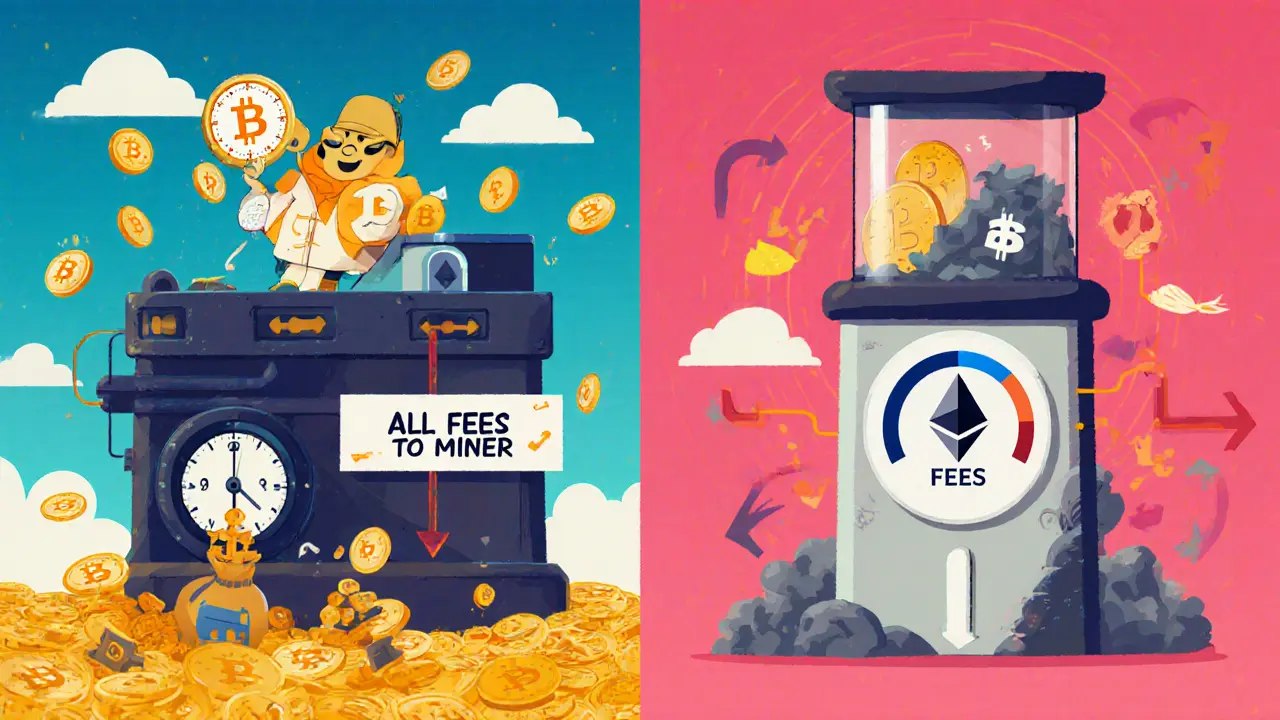
- 8 Sep 2025
- Elara Crowthorne
- 24
Block Reward vs Transaction Fees Calculator
Reward Breakdown
Ever wondered why Bitcoin and Ethereum keep working even when no one is paying anyone to "run" them? The secret lies in two income streams that miners or validators chase: the block reward and transaction fees. Understanding how these two pieces fit together helps you see why the networks stay safe, how fees can swing wildly, and what the future might hold.
What a Block Reward Actually Is
In the world of crypto, a block reward is the total payout a miner or validator receives for adding a new block to the chain. It has two parts:
- Block subsidy - newly minted coins that didn’t exist before the block was created.
- Transaction fees - the leftover bits from each transaction that users pay to get their data included.
The subsidy is the big, predictable chunk. In Bitcoin, the subsidy started at 50 BTC and halves roughly every four years. That schedule creates a hard‑capped supply of 21 million coins and keeps inflation in check.
How Transaction Fees Work
Every time you send crypto, you add a fee. Technically it’s the difference between the inputs you spend and the outputs you receive. Miners see a pool of pending transactions (the "mempool") and cherry‑pick the highest‑paying ones. The more you pay per byte, the quicker your transaction lands in a block.
Fees aren’t just a annoyance; they act as a spam‑deterrent and, over time, become a crucial part of the reward mix. When the block subsidy shrinks, fees pick up the slack.
Bitcoin vs. Ethereum: Two Different Reward Models
Both Bitcoin and Ethereum use block rewards, but the way they split the pie is worlds apart.
| Component | Bitcoin (Proof‑of‑Work) | Ethereum (Proof‑of‑Stake) |
|---|---|---|
| Block Subsidy | Newly minted BTC, halves every 210,000 blocks (≈4years) | No minting reward; validators earn staking yields |
| Transaction Fees | All fees go to the miner who found the block | ~50% of fees are burned (EIP‑1559), remainder to validators |
| Supply Cap | 21million BTC (hard cap) | No hard cap; issuance varies with staking participation |
Notice how Ethereum’s fee‑burning mechanism can make the network deflationary when activity spikes, while Bitcoin simply hands all fees to the miner.

Why Fees Can Outweigh Subsidies - A Real‑World Snapshot
On December222017, Bitcoin’s price was soaring and the network was jammed. Transaction fees that day made up 78% of the total block reward. In raw numbers, miners earned 7,268BTC in fees versus about 2,050BTC from the subsidy. That single day showed how a fee‑heavy market can flip the reward balance.
Fast‑forward to 2023‑2024: after the 2024 halving, the subsidy fell to 3.125BTC. Fees now commonly contribute 30‑45% of a miner’s earnings, and during congestion spikes they can push past 60%.
Security Implications: When Subsidies Fade
As Bitcoin’s subsidy keeps halving, the network leans more on fees for security. Researchers at River Financial argue that without a strong fee market, miners could earn too little to justify the electricity they burn, potentially weakening the hash rate.
Ethereum’s shift to proof‑of‑stake changes the game. Validators lock up ETH as collateral and earn a yield that includes the non‑burned portion of fees. The stake‑based model means security comes from the amount of ETH locked, not from a volatile fee income.
Both designs aim for a “fee‑dependent” future, but they get there in different ways. Bitcoin relies on an ever‑growing fee market, while Ethereum couples fees with staking rewards and a built‑in deflationary burn.
How to Estimate Fees - Practical Tips
If you’re sending a transaction, you have three basic strategies:
- Check the mempool - tools like mempool.space show current fee rates per byte. Aim for the "fast" column if you need speed.
- Time your send - fees drop when activity eases (often early mornings UTC).
- Use fee‑estimation libraries - many wallets integrate APIs that auto‑suggest a fee based on recent blocks.
For Ethereum, remember that part of the fee might be burned, so the amount you actually pay could be higher than the validator reward you see.

What the Future Holds for Block Rewards
The next Bitcoin halving is slated for 2028, cutting the subsidy to 1.5625BTC per block. Analysts expect transaction fees to claim a larger slice of miner income, especially if Bitcoin adoption keeps rising.
Ethereum continues to tweak its fee model. Proposals on EIP‑4844 (proto‑Danksharding) aim to lower transaction costs, which could reduce the fee burn’s impact and shift more reward back to validators.
In both cases, a healthy fee market is the backbone of long‑term security. Networks that can generate enough fee revenue will stay robust, while those that can’t may need to adjust their monetary policy.
Quick Takeaways
- A block reward = block subsidy + transaction fees.
- Bitcoin’s subsidy halves every four years; Ethereum rewards come from staking.
- During congestion, fees can outstrip subsidies - as happened in 2017.
- Future security now leans on fee markets more than ever.
- Estimating fees early and using low‑traffic windows saves money.
Frequently Asked Questions
What exactly is a block subsidy?
A block subsidy is the newly created cryptocurrency that a miner or validator receives when they successfully add a block to the chain. In Bitcoin, this subsidy started at 50BTC and halves roughly every 210,000 blocks.
Why do transaction fees matter for network security?
Fees give miners or validators a direct financial incentive to include transactions and keep the chain honest. As subsidies shrink, fees become the primary revenue source, which means a strong fee market is essential for maintaining a high hash rate or sufficient stake.
How does Ethereum’s fee‑burn mechanism work?
When a user sends an Ethereum transaction, part of the fee (the base fee) is automatically destroyed, removing those ETH from circulation. The remaining tip goes to the validator who proposes the block. This can create deflationary pressure when network activity is high.
Will Bitcoin miners earn less after the 2028 halving?
The subsidy will drop to 1.5625BTC per block, so miners will rely more on transaction fees. If fee demand stays strong, total earnings may stay similar; if fees fall, miner revenue could shrink, potentially affecting network hash rate.
How can I lower my transaction fees?
Watch fee‑estimation tools, send transactions during off‑peak hours, and consider using SegWit addresses (for Bitcoin) or layer‑2 solutions like Lightning or rollups (for Ethereum) to reduce on‑chain fee exposure.




24 Comments
Understanding how block rewards and transaction fees work together is crucial for anyone invested in crypto security. The reward mechanism ensures miners stay motivated to validate transactions, while fees act as a supplemental incentive. When the block subsidy shrinks, fees become a larger portion of miners' income, which can affect hash rate stability. It’s also worth noting that higher fees can discourage small transactions if they become too costly. Overall, the balance between these two sources keeps the network robust.
Wow, imagine the sheer drama of a network where fees start to dominate the miners' paycheck! 🌟 As the subsidy halves, it's like a plot twist where the underdog fees step into the limelight. This shift can spark a surge of innovation as miners hunt for efficient fee strategies. The community feels the excitement, and every transaction becomes a pulse in the grand narrative. It's a thrilling evolution that keeps the blockchain alive and kicking!
Sure, fees are important, but let’s not act like they’re the be-all and end-all of network security. After all, the proof‑of‑work core still does the heavy lifting. If you start over‑relying on fees, you risk encouraging miners to cherry‑pick only high‑fee transactions, leaving low‑value ones neglected. The balance has always been about incentives, not a fee‑only model. Keep the subsidies alive longer, and you keep the network healthy.
It’s morally reprehensible to ignore the environmental cost of proof‑of‑work while obsessing over fee structures. The world cannot continue to subsidize energy‑intensive mining just for the sake of a few extra satoshis. If the community truly cared about sustainability, we’d prioritize proof‑of‑stake designs that reduce waste. Transaction fees shouldn’t be an excuse to keep destructive practices alive. We must call out this short‑sighted greed and demand greener solutions now.
Indeed, the moral argument you present, while earnest, may overlook the intricate economic incentives embedded within the Bitcoin protocol; consequently, the fee market dynamics deserve a nuanced examination!!! The subsidy reduction does not singularly dictate miner behavior; rather, it interacts with transaction prioritization, mempool pressure, and network latency-factors that collectively shape security outcomes.
From a technical standpoint, the block reward formula is simple: subsidy plus fees equals total miner revenue. When Bitcoin’s subsidy halves, the fee share must rise to maintain the same incentive level. Historically, fee revenue has been volatile, but long‑term trends show it can sustain the network if transaction volume grows. Keep an eye on fee spikes during market stress-they’re a good barometer of miner profitability.
What most people don’t realize is that the fee market is subtly manipulated by hidden actors in the mining pools. There are whispers of off‑chain agreements where large miners collude to set minimum fee thresholds, ensuring a steady income even as subsidies dwindle. This covert operation isn’t talked about openly, but it’s a critical piece of the puzzle. If you’re serious about decentralization, you need to dig deeper into these shadow fee structures.
Let’s keep the conversation constructive-yes, secrets can exist, but the beauty of open‑source protocols is that anyone can audit the fee data! By analyzing block explorers and mempool trends, the community can shine a light on any suspicious patterns. Transparency is our strongest ally, and together we can ensure that fees remain a fair incentive rather than a tool for collusion.
In many regions, the cultural perception of transaction fees influences adoption rates. For example, in countries where micro‑transactions are common, high fees can deter users from entering the ecosystem. Designing fee structures that adapt to local economic conditions can foster broader participation. Moreover, educational outreach about how fees support network security helps demystify the concept for newcomers.
That’s a great point-educating users about the role of fees can definitely boost confidence. Think of it like a coach reminding athletes why training matters; the same principle applies to miners and transaction fees. Keep spreading that knowledge, and the community will feel more empowered to contribute.
While the mainstream narrative praises fee markets, one must question whether this paradigm truly aligns with decentralization. If fees become the primary reward, only those with substantial capital can afford to stay competitive, potentially centralizing hash power. This raises philosophical concerns about who truly benefits from the network’s design. The fee structure could inadvertently create a plutocracy, contradicting the original ethos.
Honestly, it’s fascinating how quickly the conversation shifts to abstract philosophy when concrete data shows fee revenue actually supporting smaller miners during bull runs. You’re over‑thinking the issue; the numbers speak for themselves. Let’s stay grounded in reality rather than spiraling into hypothetical elitism.
Oh sure, because every crypto enthusiast is a saint who never cares about profits. Let’s all pretend fees are some altruistic gift when, in reality, they’re a clever way to keep miners greedy. The whole “security” argument is just a marketing ploy-nice try.
i feel u, fees can be a pain but they also keep the netowrk safe. if u r new to crypto try not to get overwhelmed, just take it step by step. watch how fee rates change over time and u’ll get the hang of it.
In light of recent subsidy reductions, it is imperative that stakeholders adopt a collaborative stance toward fee optimization. By engaging in rigorous analysis and fostering open dialogue, we can ensure that miner remuneration remains sufficient to safeguard the network's integrity. Let us therefore prioritize transparency and shared responsibility in all future protocol deliberations.
Great insights! Remember, a supportive community can help newcomers navigate fee spikes without feeling discouraged. Just like a coach, we can guide each other towards smarter transaction timing and better network health.
First, let us acknowledge that the entire discourse surrounding block rewards and transaction fees is riddled with hidden assumptions that most casual observers never even consider. One must examine the historical context of Bitcoin’s reward schedule, which was deliberately engineered to halve every 210,000 blocks, thereby creating a predictable decay in subsidy. This decay, however, is not an isolated phenomenon; it intertwines with the fee market in ways that are both subtle and profound. As the subsidy diminishes, miners become increasingly dependent on the transaction fee pool, which in turn incentivizes them to prioritize high‑fee transactions, potentially marginalizing low‑value transfers. Moreover, the fee market’s volatility introduces an element of economic uncertainty that can destabilize miner revenue streams, especially during periods of market stress. That is why many in the community argue for a dynamic fee adjustment mechanism, one that can respond in real time to fluctuations in transaction volume and network congestion. Yet, the implementation of such a mechanism raises complex governance questions, not to mention technical challenges related to consensus and protocol upgrades. Furthermore, one cannot ignore the psychological impact on miners who have historically relied on the certainty of block subsidies; sudden shifts toward fee‑dominant rewards could erode confidence, leading to a potential exodus of hash power. This scenario is particularly concerning when we consider the security implications of reduced mining participation. In addition, the rise of layer‑2 solutions, such as the Lightning Network, alters the fee landscape by moving many transactions off‑chain, thereby reducing on‑chain fee revenue. While this enhances scalability, it also diminishes a critical source of miner income, further complicating the reward equation. Therefore, an exhaustive analysis must also factor in the long‑term effects of these scaling solutions on the fee market’s sustainability. In sum, the interplay between block rewards and transaction fees is a multifaceted construct that demands a holistic approach, incorporating economic modeling, game theory, and sociotechnical considerations. Only through such comprehensive scrutiny can we hope to preserve the network’s security and decentralization aspirations for the decades to come.
The fee landscape varies across cultures; some regions prioritize fast confirmations, while others value low costs more. Understanding these preferences helps developers design fee algorithms that serve a global audience. By customizing fee estimations based on local usage patterns, we can make crypto more inclusive and secure.
When analyzing miner incentives, it’s useful to apply philosophical rigor: consider the principle of fair compensation versus the utilitarian benefit of a secure ledger. By balancing these concepts, we can articulate a more nuanced policy that respects both individual miners and the collective good.
Look, if fees aren’t ramped up fast enough, miners will abandon the chain-! This will devastate security, and we can’t let that happen, so let’s push for higher fee incentives now!!!
Honestly folks, the fee debate is getting so overblown. I think we’re all just overthinking simple economics. Anyway, let’s just keep mining and hope the market sorts itself out.
There’s definitely a hidden agenda in the way fee structures are presented-big players want to keep us dependent on their mining pools. The truth is being suppressed, and only a few know the real numbers.
Fees keep miners honest.
From a protocol engineering perspective, the fee‑per‑byte metric optimizes mempool throughput, yet it also creates a gamified environment where miners exploit fee‑rate arbitrage, leading to subtle centralization pressures.